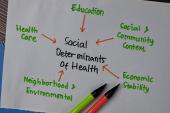Higher CV Mortality Among More Socially Vulnerable US Adults
In order to keep improving CV outcomes nationwide, public health interventions and policies are needed, some say.

The term refers to the potential for negative community health effects based on external stressors including socioeconomic status, housing, and minority status.
The findings come on the heels of another study published this month in JAMA showing the scope to which social determinants of health have driven racial disparities in cardiovascular health in the United States. Other research, including an analysis published last year, has demonstrated the additive burdens these risk factors can have on cardiovascular mortality.
“The key message of our study is that the conditions in which we are born, live, grow, and work influence our cardiovascular health,” lead author Safi U. Khan, MD, MS (Houston Methodist DeBakey Heart & Vascular Center, Houston, TX), told TCTMD. These factors “should be given critical importance in medical and public health interventions.”
Proactively identifying socially vulnerable groups will be key to improving care across the country, he added, noting that the study pointed to women, non-Hispanic Blacks, and residents of rural counties as being at the highest risk. “Targeting these vulnerable demographic groups to improve care may yield maximal cardiovascular survival benefits, which in turn can improve the current concerning state of cardiovascular morbidity and mortality in the United States,” said Khan.
What the study adds to the literature is that the specific score used, the Social Vulnerability Index (SVI), can be used to look at patients with cardiovascular disease, although each of its individual components have already been shown to be associated, commented Haider Warraich, MD (Brigham and Women’s Hospital, Boston, MA). “I do hope the study brings the challenge that we're facing in cardiovascular health back to the forefront in that to achieve improvements in cardiovascular health, we will hit a plateau if we don’t expand or widen our lens into what are the factors that are leading to poor outcomes,” he told TCTMD.
SVI Matters for CV Mortality
For the study, published in the October 19, 2021, issue of Circulation, Khan and colleagues linked county-level Centers for Disease Control and Prevention (CDC) databases to review SVI scores as well as cardiovascular mortality across the country between 2014 and 2018. The SVI is a score ranging from 0-1 made up of 15 attributes that are broken into four subcomponents: socioeconomic status, household composition and disability, minority status and language, and housing type and transportation.
Over the study period, 607,773 cardiovascular deaths were logged with an age-adjusted mortality of 47.0 per 100,000 person-years (28.3 for ischemic heart disease, 7.9 for stroke, 8.4 for hypertension, and 2.4 for heart failure). When US counties were stratified by percentile by SVI score, the largest concentration of counties both at high risk and with high cardiovascular mortality were seen in both the southwestern and southeastern states.
Compared with counties least at risk, those in the highest SVI quartile saw higher overall cardiovascular mortality (rate ratio [RR] 1.84) as well as that related to ischemic heart disease (RR 1.52), stroke (RR 2.03), hypertension (RR 2.71), and heart failure (RR 3.38).
Demographics greatly varied the results, however. Notably, non-Hispanic Black adults living in fourth-quartile SVI counties had the highest cardiovascular mortality among all ethnicities, particularly driven by stroke and heart failure mortality. Also, those living in rural counties with high SVIs reported mortality rates two- to fivefold higher. Women were generally at higher risk than men.
Age-Adjusted Mortality Rate Ratios: 4th vs 1st SVI Quartile Counties
|
|
CVD |
Ischemic Heart Disease |
Stroke |
Hypertension |
Heart Failure |
|
Sex |
|||||
|
Men |
1.75 |
1.46 |
2.18 |
2.53 |
3.50 |
|
Women |
2.09 |
1.83 |
1.91 |
3.07 |
3.20 |
|
Ethnicity |
|||||
|
Non-Hispanic White |
1.72 |
1.56 |
1.71 |
2.29 |
2.90 |
|
Non-Hispanic Black |
1.56 |
1.38 |
1.65 |
1.62 |
2.42 |
|
Hispanic |
1.35 |
1.35 |
1.24 |
1.67 |
0.78 |
|
County Type |
|||||
|
Urban |
1.76 |
1.51 |
1.90 |
2.41 |
2.92 |
|
Rural |
2.13 |
1.69 |
2.56 |
3.60 |
5.75 |
“While we have consistently seen the influence of social determinants of health on cardiovascular outcomes, what is more important is that in addition to identifying target groups, this study also allowed us to identify the hot spots in the US,” Khan said.
He called for “massive public health intervention strategies and policies” to reduce the burden of premature cardiovascular disease, especially in those with the greatest social vulnerability. Khan said his team is working on developing and validating a polysocial risk score that can be integrated into health systems and applied at the patient level, allowing clinicians to precisely identify vulnerable individuals who are at the greatest risk.
‘We Can’t Do This On Our Own Anymore’
Warraich referred to the evolution of cardiovascular disease as “increasingly becoming a disease of disadvantaged people.” While there are many effective treatments for cardiovascular disease generally, as well as for diabetes, heart failure, hypertension, and coronary disease more specifically, he explained, “the real challenge we are facing right now is getting the treatments to the people who need them the most.”
While the prior face of cardiovascular disease once seemed to be the “affluent businessman,” now things have changed, Warraich continued. “That also means that now many of the people who get cardiovascular disease won’t have the means for having access to expensive medical therapies,” he said. “It isn’t just going to be about developing new therapies and drugs. In fact, I might say that the benefits that we expect from technological advances are going to be more limited because we are going to run into this wall of social disadvantage that we're seeing and what this study is confirming.”
In an accompanying editorial, Apoorva Gangavelli, BS, and Alanna A. Morris, MD, MSc (both Emory University School of Medicine, Atlanta, GA), point to how much the COVID-19 pandemic has uncovered about the effect of social vulnerability on public health. “Most clinicians, patients, and public health officials would agree that reducing the burden of premature CVD is a critical battle that we must meet head-on,” they write. “The current analysis by Khan et al identifies regions and populations that are more vulnerable to premature CVD and indicates the importance of addressing socioeconomic disparities in this effort. The challenge is identifying the practical interventions that can be implemented in vulnerable regions.”
But on a national scale, they ask: “Who will protect the most vulnerable among us?” Change can only come from changes in health policy “that enable positive therapeutic and healthy lifestyle behaviors in vulnerable communities” as well as those that improve healthcare access overall, Gangavelli and Morris write. “Without addressing these social determinants of health, the achievements previously made in CVD prevention and treatment remain vulnerable to reversal.”
For now, Warraich urged clinicians to assess social risk in each of their patients to more closely monitor the most vulnerable and find them at least temporary solutions. Specifically, he advised, for patients who might be having trouble affording medications, consult a financial counselor or social worker to find low-cost options. For patients with limited transportation, see if virtual care would work for them, Warraich suggested.
“I hope that work like this can really cement for clinicians that what we do in clinical medicine is not just about what we do in the clinic or the hospital,” he concluded. “It has to be bigger than that. It has to be tied to social intervention and social change, and it has to be working with policy makers. We can’t do this on our own anymore.”
Yael L. Maxwell is Senior Medical Journalist for TCTMD and Section Editor of TCTMD's Fellows Forum. She served as the inaugural…
Read Full BioSources
Khan SU, Javed Z, Lone AN, et al. Social vulnerability and premature cardiovascular mortality among US counties, 2014 to 2018. Circulation. 2021;144:1272-1279.
Gangavelli A, Morris AA. Premature cardiovascular mortality in the United States: who will protect the most vulnerable among us? Circulation. 2021;144:1280-1283.
Disclosures
- Khan, Gangavelli, and Morris report no relevant conflicts of interest.
- Khan, Warraich, Gangavelli, and Morris report no relevant conflicts of interest.





Comments